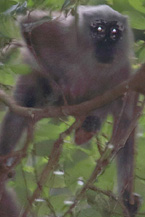Get
To Know
|
 The Moor Macaque is endemic to the tropical rainforests and
grasslands of the island of Sulawesi in Indonesia. Their diet consists
of they eat figs, bamboo seeds, buds, sprouts, invertebrates and
cereals. They have brown to black body fur with a pale rump patch
and pink bare skin on the rump and are about 55 centimetres in height.
They are sometimes called a "dog-ape" because of their dog-like
muzzle, although they are no more closely related to apes than any
other Old World monkey. Adult male moor macaques do not interact
frequently, although the interactions that occur frequently involve
affiliation rather than aggression, with greetings being the most
common form of interaction. The greetings enable males to show their
willingness to invest in the relationship, and may represent one
way for adult males to ease social tension and build social bonds.
The moor macaque is threatened mostly due to habitat loss from an
expanding human population and deforestation to increase agricultural
land area. The population is estimated to have decreased from 56,000
to under 10,000 from 1983 to 1994. In 1992, Supriatna et al. conducted
an extensive survey and found only 3,000-5,000 individuals of the
species. The survey estimated densities to be 25-50 individuals
per kilometre. Several Sulawesi macaque species are endangered,
and information on their ecology and behaviour is desperate needed
if conservation plans are to be effective.
The Moor Macaque is endemic to the tropical rainforests and
grasslands of the island of Sulawesi in Indonesia. Their diet consists
of they eat figs, bamboo seeds, buds, sprouts, invertebrates and
cereals. They have brown to black body fur with a pale rump patch
and pink bare skin on the rump and are about 55 centimetres in height.
They are sometimes called a "dog-ape" because of their dog-like
muzzle, although they are no more closely related to apes than any
other Old World monkey. Adult male moor macaques do not interact
frequently, although the interactions that occur frequently involve
affiliation rather than aggression, with greetings being the most
common form of interaction. The greetings enable males to show their
willingness to invest in the relationship, and may represent one
way for adult males to ease social tension and build social bonds.
The moor macaque is threatened mostly due to habitat loss from an
expanding human population and deforestation to increase agricultural
land area. The population is estimated to have decreased from 56,000
to under 10,000 from 1983 to 1994. In 1992, Supriatna et al. conducted
an extensive survey and found only 3,000-5,000 individuals of the
species. The survey estimated densities to be 25-50 individuals
per kilometre. Several Sulawesi macaque species are endangered,
and information on their ecology and behaviour is desperate needed
if conservation plans are to be effective.
|
|
|
|
Sarajevo Monday
by
James Hannon
Waken at dawn
to a muezzin's call
from a nearby minaret.
"Hayya alas Salah; Hayya alal Falah."
Hasten to prayer; hasten to success.
Prayer is better than sleep.
Follow footprints in the sand
of Sarajevo sidewalks
where mortar can still fall
from the walls above you,
to the market where mortars
lobbed from hillsides mingled
animal, vegetable, mineral.
Among your twenty questions-
Is it a species that kills for pleasure?
Those are roses painted
on sidewalks where victims fell.
That cemetery sprouts rows
of identical white stiles.
Now to the old town
where young Muslim women
have colored their hair
fuchsia, magenta, crimson.
Walk past ruins of a caravanserai
to the ancient bazaar cornered by
a cathedral, a mosque, a synagogue.
A collective effort feeds
these wild dogs at the market.
They seem wary of strangers
but they know their friends.
Walk down Ferhadija Street
to where you're welcomed into
the courtyard of the old mosque.
Please observe the symbols:
no smoking, no short skirts, no guns.
In a cafe on Dulagina Cikma
hear the death metal rap of Necro
"I'll hit that pussy up with a nasty attack"
followed by Marley's "One Love."
Up in the hills after-school children
play around a broken fountain.
Behind them eighty names
are carved in a marble wall--
wide-ranging birth years
and a three year range for deaths.
Abdullah, Rabia, Mohammad.
A chubby boy is teased by the others.
Two adults, maybe teachers,
encourage him to re-engage,
and stay to watch.
The children play again.
James Hannon is a clinical sociologist and political activist
in Massachusetts. His poems have appeared in Blue Lake Review, Cold
Mountain Review, The Fear of Monkeys, Muddy River Poetry Review, Soundings
East, and other journals, and in Gathered: Contemporary Quaker
Poets (Sundress, 2013). His collection, The Year I Learned the
Backstroke, was published by Aldrich Press. "Sarajevo Monday"
was Previously published in Courtship of Winds, Winter 2016
|
 The
Moor Macaque - Issue
Thirty-Five
The
Moor Macaque - Issue
Thirty-Five